- About
- Topics
- Story
- In-Depth
- Picks
- Opinion
- News
- Donate
- Signup for our newsletterOur Editors' Best Picks.Send
Read, Debate: Engage.
| July 09, 2025 | |
|---|---|
| topic: | Pollution |
| tags: | #Indonesia, #plastic pollution, #water pollution, #air pollution |
| located: | Indonesia |
| by: | Primagung Dary Riliananda, Garry Lotulung |
Mounds of plastic waste are clearly visible in the middle of residential areas in Indonesia’s Gedangrowo Village, Sidoarjo Regency. One of the largest dumpsites for imported waste of East Java, approximately an 11-hour drive away from Jakarta. Some of the trash appears dried, with brand labels unfamiliar to Indonesians, an indication that the waste originated overseas.
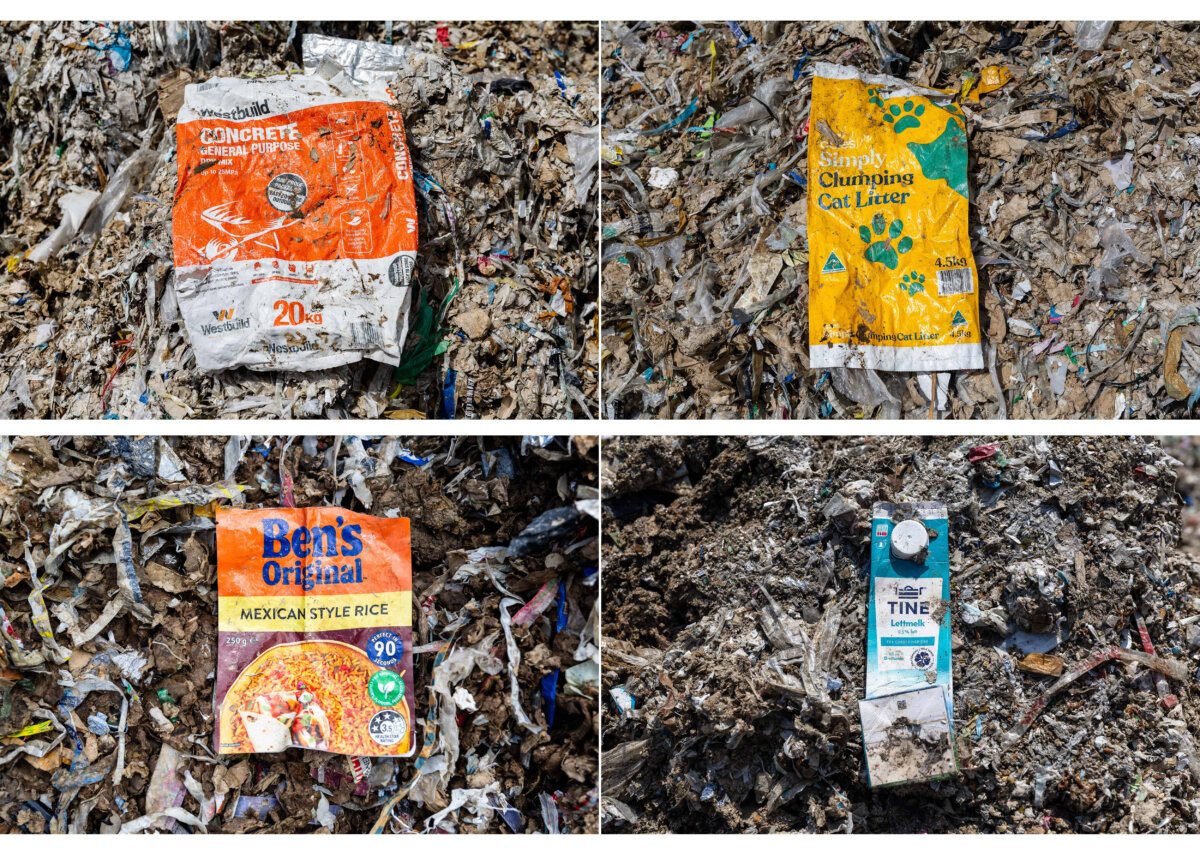
Foreign plastic packaging products are pictured at an import plastic waste dump in Sumberejo village, Malang Regency, East Java, Indonesia, 31 May, 2025.
Just a five-minute drive from Gedangrowo, residents of Bangun Village in Mojokerto Regency are seen sorting garbage next to their homes, while others leave it to dry by the roadside.
About 110 kilometres south of Sidoarjo and Mojokerto, similar scenes can be found in Sumberrejo Village, Pagak District, Malang Regency. Typically, the streets in front of homes are used to dry agricultural products, but residents here use their yards to sun-dry chopped-up waste.
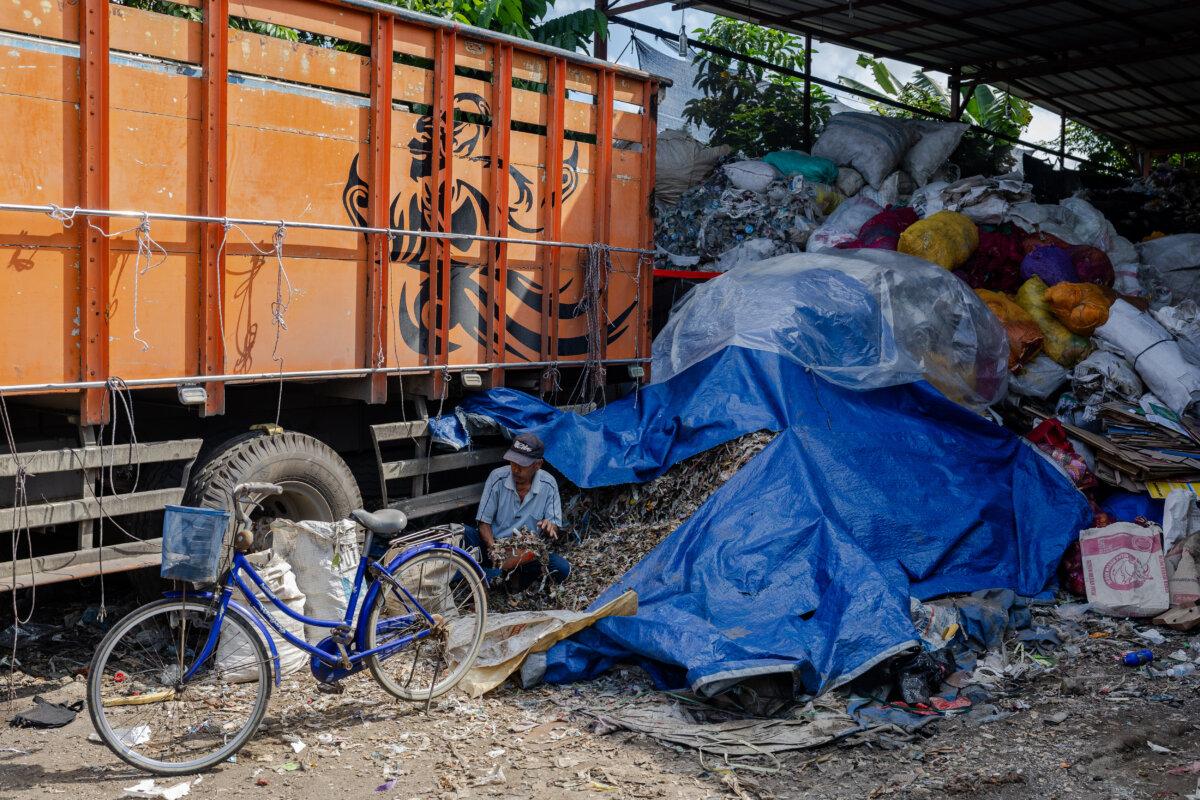
A man collects plastic waste from an area of land designated for waste dumping in Gampingan village, Malang Regency, East Java, Indonesia, May 30, 2025. The village has been inundated by plastic waste imported from such countries as Europe, America, Australia, Japan and South Korea.
Sapi’i and Siyah, a married couple, work along the village road, which is now nearly buried in garbage. Since returning from Jakarta in 1992, Sapi’i has relied on these garbage piles for a living. They purchased the waste from PT Ekamas Fortuna - a nearby paper factory that imports foreign waste - and sort it by material: paper and plastic. "Each truck usually requires a delivery fee of IDR150,000 (USD 9.26)," Sapi’i said.
It takes Sapi’i and Siyah over a month to process a single batch. The drying process will be faster if the weather is clear. The sorted paper waste is sold back to the factory, earning them a sorter’s wage. Meanwhile, dry plastic is sold to other garbage collectors for IDR 250,000 (USD 15.44) per truckload.
Nearby, Hamidah with her mother-in-law Saiful, were busy sorting the waste. Their hands worked fast in collecting and stuffing recyclable items into sacks. "I’ve never found any money in the trash, but my neighbour once found a few riyals. She exchanged them in Kepanjen (the capital of Malang Regency) and used the money to buy rice," Hamidah said.
They - and more than 1,500 other families in Pagak District - are used to being called "dirty workers". Nevertheless, the garbage has brought jobs, "we’ve been doing this for over 30 years," she continued.
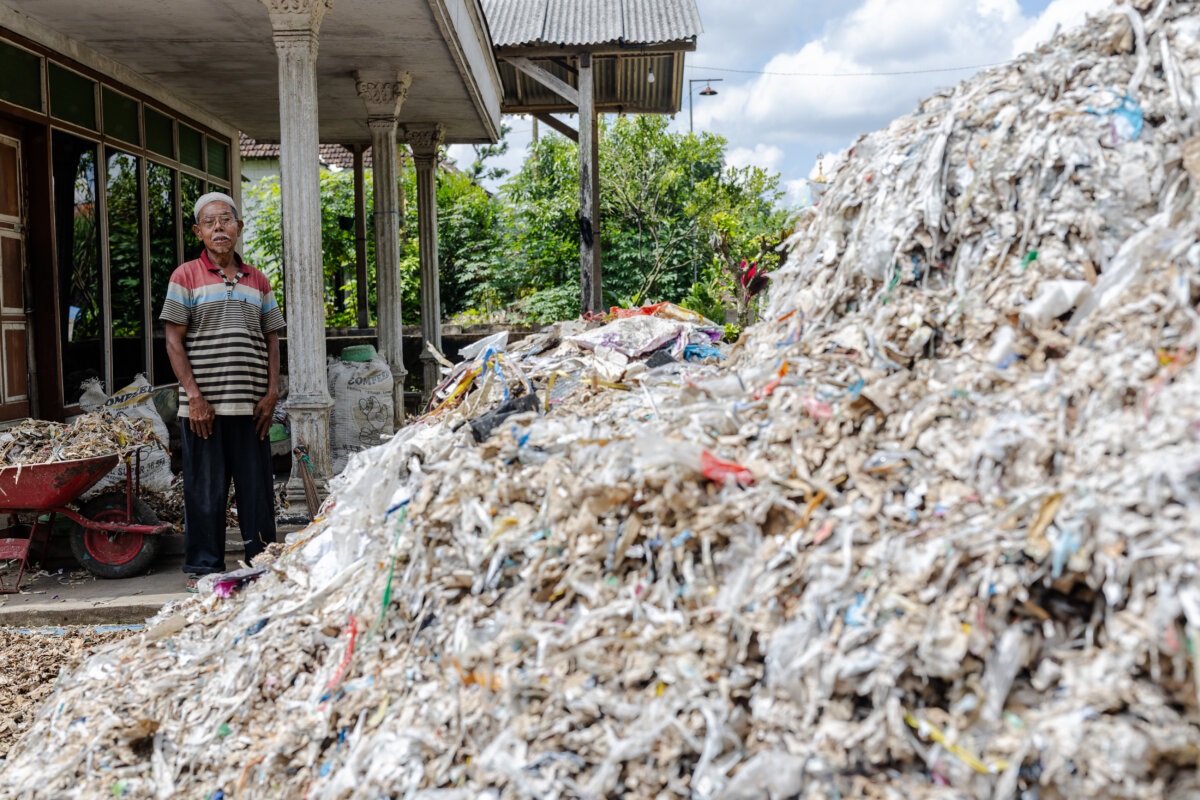
Suid, 63, poses for a photo in front of his house, surrounded by imported plastic waste in Sumberejo village, Malang Regency, East Java, Indonesia, May 30, 2025.
Gedangrowo, Bangun and Pagak are among several villages in East Java that have become dumping grounds for imported waste, which is funnelled through local paper factories.
The factory directly takes the imported waste, then distributes it to the sorting village after they process it for the first time inside the factory. The waste is residue from paper recycling processes. It includes a mix of paper pulp, plastic food and beverage packaging, and even electronic waste. Many of the products are recognisable as having been sold in European Union countries, Australia, the United Kingdom and Japan.
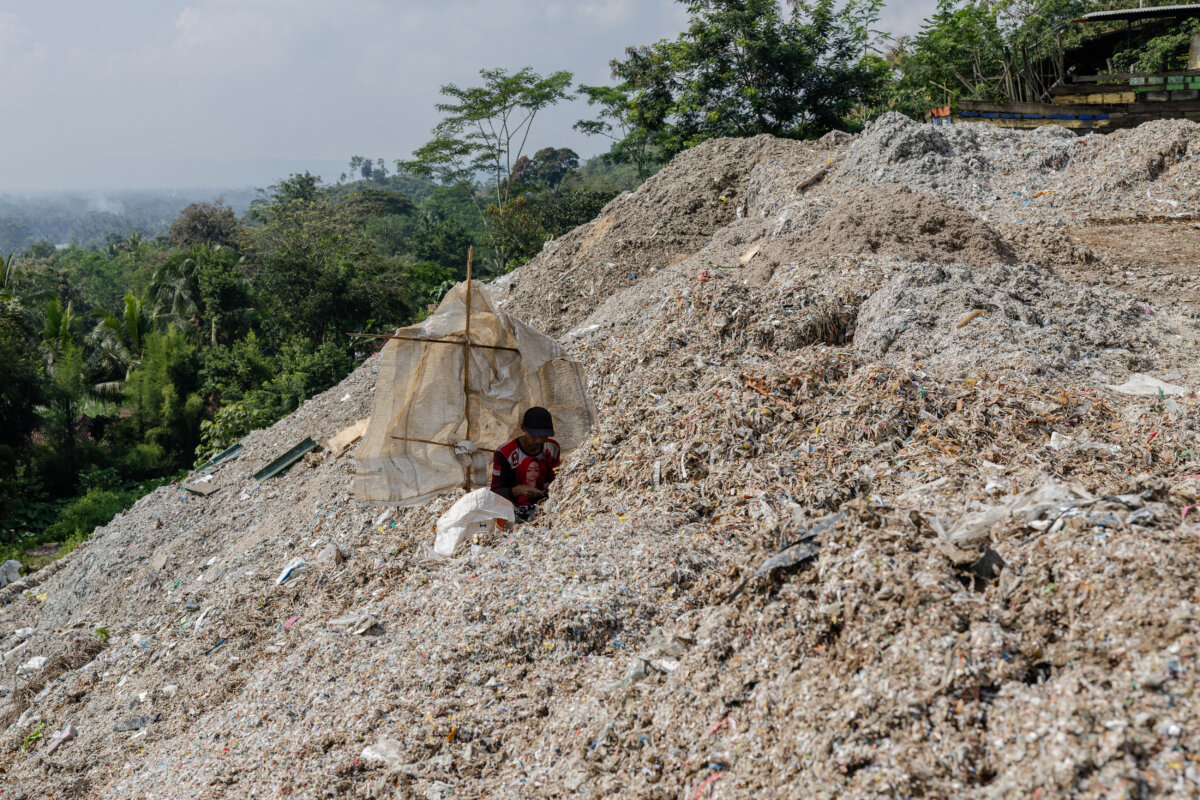
A man collects plastic waste from an area of land designated for waste dumping in Sumberejo village, Malang Regency, East Java, Indonesia, 31 May, 2025. The village has been inundated by plastic waste imported from such countries as Europe, America, Australia, Japan and South Korea.
In Indonesia, the waste import boom took off in the early 2000s. According to UN Comtrade, Indonesia imported 2,900 tonnes of plastic waste in 2000. Since then, the volume has continued to rise. In 2022, Indonesia became the world’s third-largest plastic waste importer, receiving more than 194,000 tonnes of waste.
Following China's ban on plastic waste imports in 2018, Indonesia experienced in the following seven years, a surge in incoming waste. According to the latest 2024 UN Comtrade data, Australia and Japan were among the largest contributors. Between 2023 and 2024, Australia shipped 22,333 tonnes of plastic waste to Indonesia, an increase of 27.9 per cent from the previous year. Japan followed, exporting an average of 12,460 tonnes, marking a 14 per cent increase.
Countries in the EU also played a major role. According to Eurostat, the EU exported a total of 8.5 million tonnes of waste globally in 2023, a 34 per cent increase from the previous year. This included paper, plastic and glass waste. Of that, Indonesia received 17 per cent of the EU’s paper waste exports and 19 per cent of its plastic waste exports.
The latest data from Indonesia’s Central Statistics Agency in 2024 reported that Indonesia imported a total of 262,900 tonnes of plastic waste, valued at approximately USD 105 million (around IDR1.7 trillion). That figure represents a 4 per cent increase from 2023, when Indonesia imported 252,300 tonnes. The Netherlands topped the list as the largest supplier, sending 107,500 tonnes. Germany and Belgium followed, with 59,100 and 28,800 tonnes, respectively.
A concerning pattern emerged: developed countries are using developing nations as dumping grounds, thereby avoiding the higher costs of recycling and waste management in their own territories.
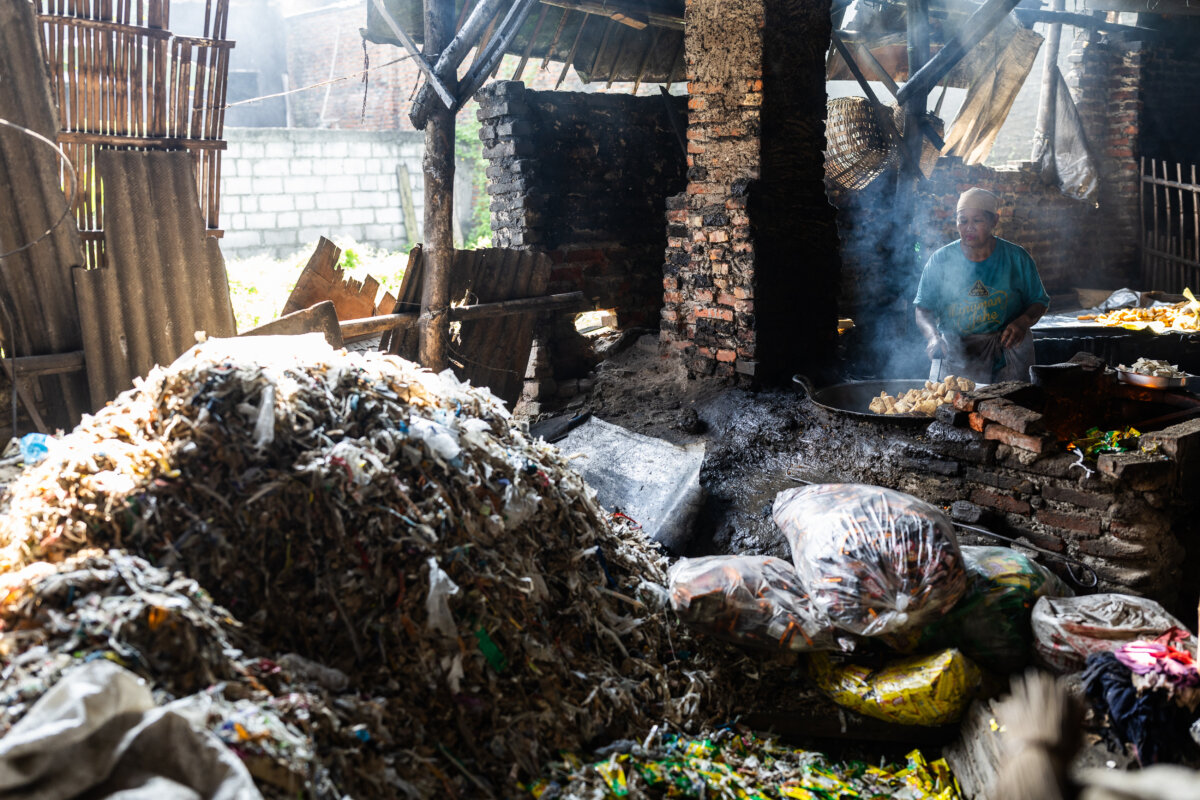
A worker fries tofu over a furnace fuelled by plastic waste in Tropodo village, Sidoarjo, East Java, Indonesia, May 28, 2025. Plastic waste from America, Europe and Asia collected for recycling, is shipped to Indonesia. Some is burned as fuel by tofu makers, producing deadly chemicals and contaminating food. The tofu is processed in boilers fuelled by burning plastic. When the plastic burns, it creates plumes of black smoke.
Seven kilometres north of Gedangrowo, thick black smoke billows from the chimney of Gufron’s tofu home industry in Tropodo Village, Sidoarjo Regency. Dozens of workers are busy inside; some are washing soybeans, while others tend to stoves to ensure the soybeans cook perfectly.
Since the 1980s, Tropodo has grown into a centre of tofu production, home to 51 tofu-making businesses and dozens of tofu-frying operations running daily. Gufron inherited the trade from his family. He recalls that in the early days, artisans used firewood, rice husks or LPG to cook soybeans. Nowadays, many have switched to burning leftover waste.
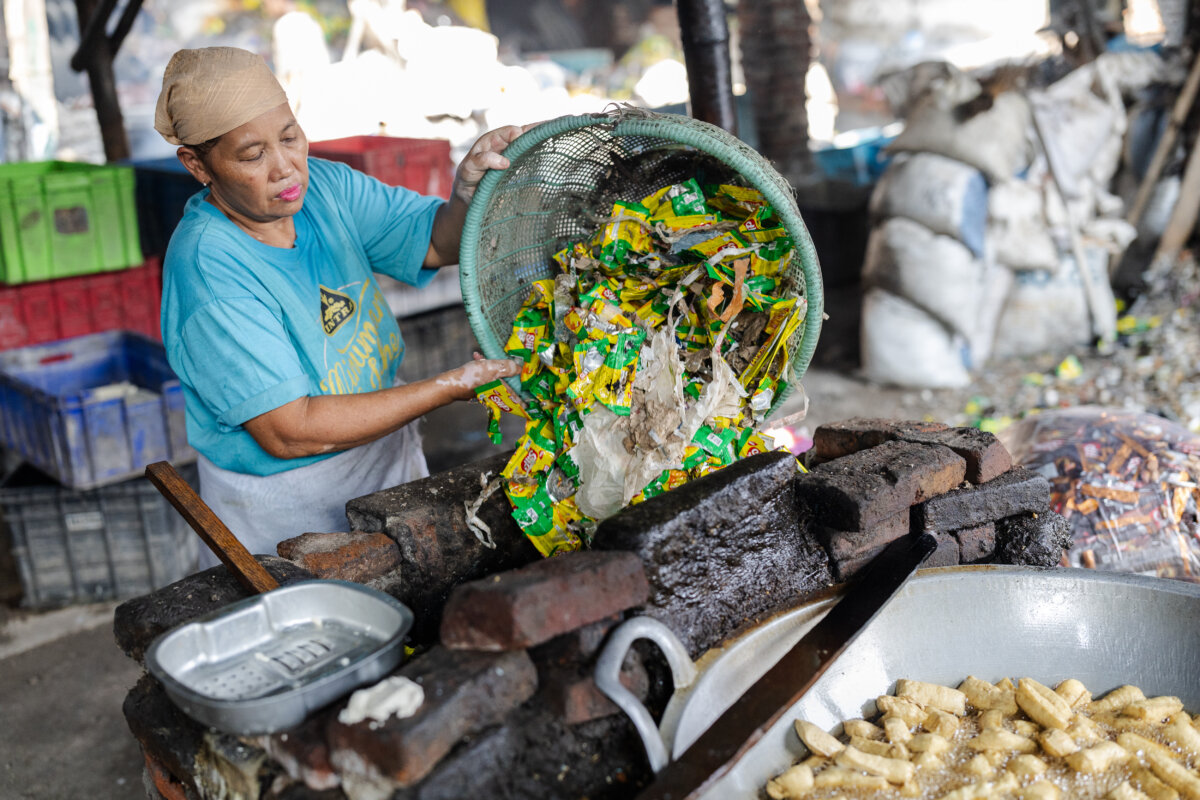
A worker adds plastic to a furnace for frying tofu at a traditional tofu factory in Tropodo village, Sidoarjo, East Java, Indonesia, May 28, 2025.
"Some tofu makers started collecting waste as a cheap source of fuel," Gufron explained. "More artisans followed eventually. Now, most of us buy it from the garbage collector."
For example, he said, one truckload of waste costs about IDR250,000 (USD 15.36) and can sustain the business for three days. It’s a lifeline for small producers, especially when soybean prices have soared. "The market price for soybeans is now around IDR9,800 (USD 0.61) per kilogram, compared to the usual IDR8,500 (USD 0.52). That’s a big difference for us since we buy in bulk," he added.
Just like in Tropodo, black smoke also rises from limestone-burning sites in Sumberrejo Village, Pagak District, Malang Regency. That morning, Jumadi, along with Ridwan and Slamet, was firing up the kiln. They take shifts guarding the limestone-filled furnace, earning IDR 110,000 (USD 6.79) per day for their efforts.
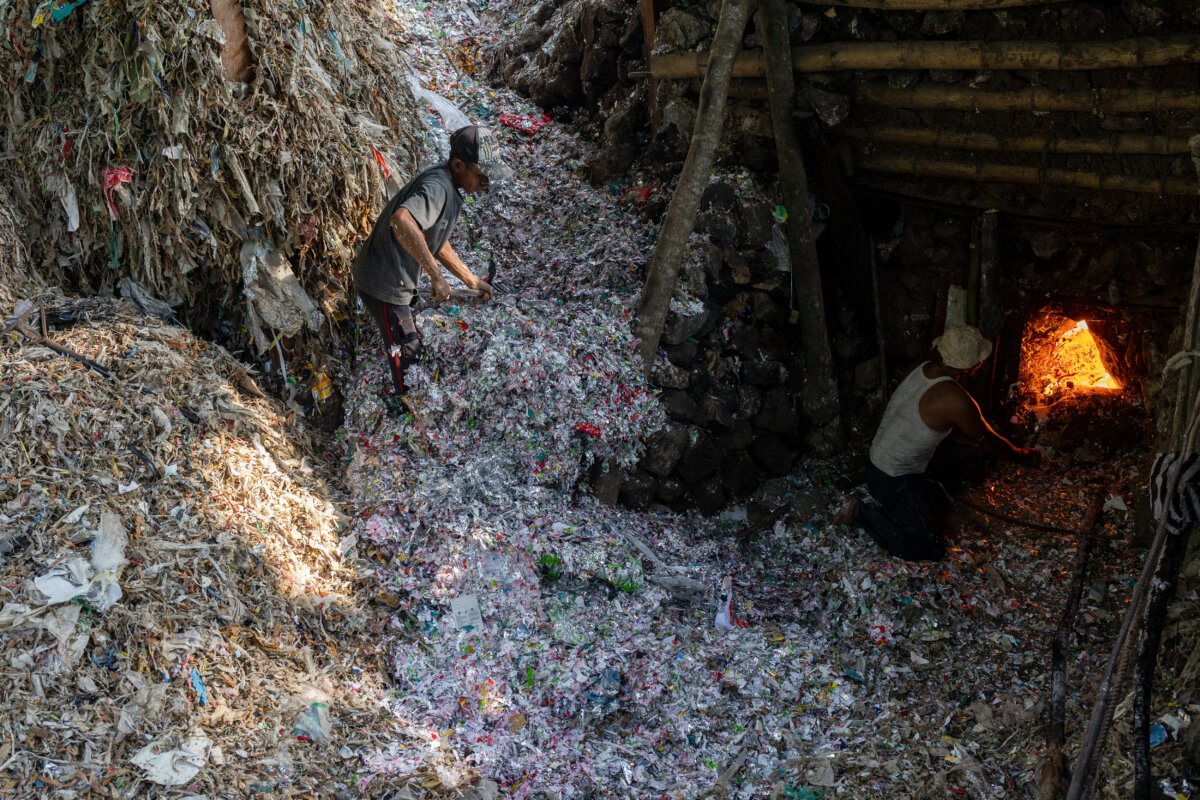
A worker pushes imported plastic waste towards the furnace during the process of burning limestone to produce lime for cement and mortar and for agricultural use in Sumberejo village, Malang Regency, East Java, Indonesia, May 31, 2025. Plastic and paper waste is the main fuel used by villagers to process limestone.
The dried plastic waste serves as fuel. Before using plastic, the kilns relied on wood. They had to spend at least IDR1.5 million (USD 92.15) to buy the wood, a figure at least six times the cost of the waste truck. The kiln must stay lit for three full days and nights to ensure the lime is fully processed. During that time, thick smoke continued to rise.
Satellite imagery observation confirms over ten active burning sites across two villages in Pagak District: Gampingan and Sumberrejo. The area’s rich limestone deposits, paired with a steady supply of waste from paper mills, have made the lime-burning industry a local mainstay.
Many local residents are unaware that the waste they sort and handle may be contaminated with hazardous substances. "Most of them sort through the trash without any personal protective equipment," said Aeshnina Azzahra Aqilani, a teenage environmental activist.
Known as Nina, she is concerned about the residents’ deteriorating health conditions if they continue to ignore it. "In Tropodo, many residents have begun suffering from respiratory infections, caused by inhaling smoke from burning waste," she said.
Still, Nina tried to understand the community. "They’re just trying to make a living from the waste around them. They earn money, but they’re also sacrificing their health," she said.
The impact on air quality is becoming more apparent in the Pagak District. Community leader Ahmad Yani noted that the smoke and ash from limestone kilns sometimes travel as far as Tlogorejo Village, four kilometres away. "Lately, there’s been a spike in lung-related illnesses in the area. We are investigating this further with students from Brawijaya University," he told FairPlanet.
Air quality in home-industry areas - both the limestone sites in Malang and the tofu producers in Sidoarjo - has been measured well beyond safe thresholds. "For vulnerable individuals, airborne particles can trigger acute respiratory conditions," said Rafika Aprilianti, a researcher at Ecological Observation and Wetland Conservation (ECOTON).
Sidoarjo’s Head of Environment and Sanitation Services, Bahrul Aming, confirmed that his office monitored three points within 300 metres of Tropodo’s tofu chimneys. "PM2.5 levels at those locations exceeded national air quality standards and pose a serious threat to public health," he explained.
A 2024 study from the Ecological Observation and Wetland Conservation (ECOTON) found that recycled high-density polyethylene (HDPE) plastics in East Java contained 346 harmful chemicals. At least 30 of these were found in dangerously high concentrations.
Even the tofu produced in Tropodo Village is unsafe. ECOTON’s 2023 study tested 12 tofu samples from different artisans, and all of them were found to be contaminated with microplastics. Researchers found 489 fibre particles, 71 filament particles and additional fragments. These microplastics are believed to originate from the plastic waste burned in furnaces, with the particles carried into food by wind or direct contact.
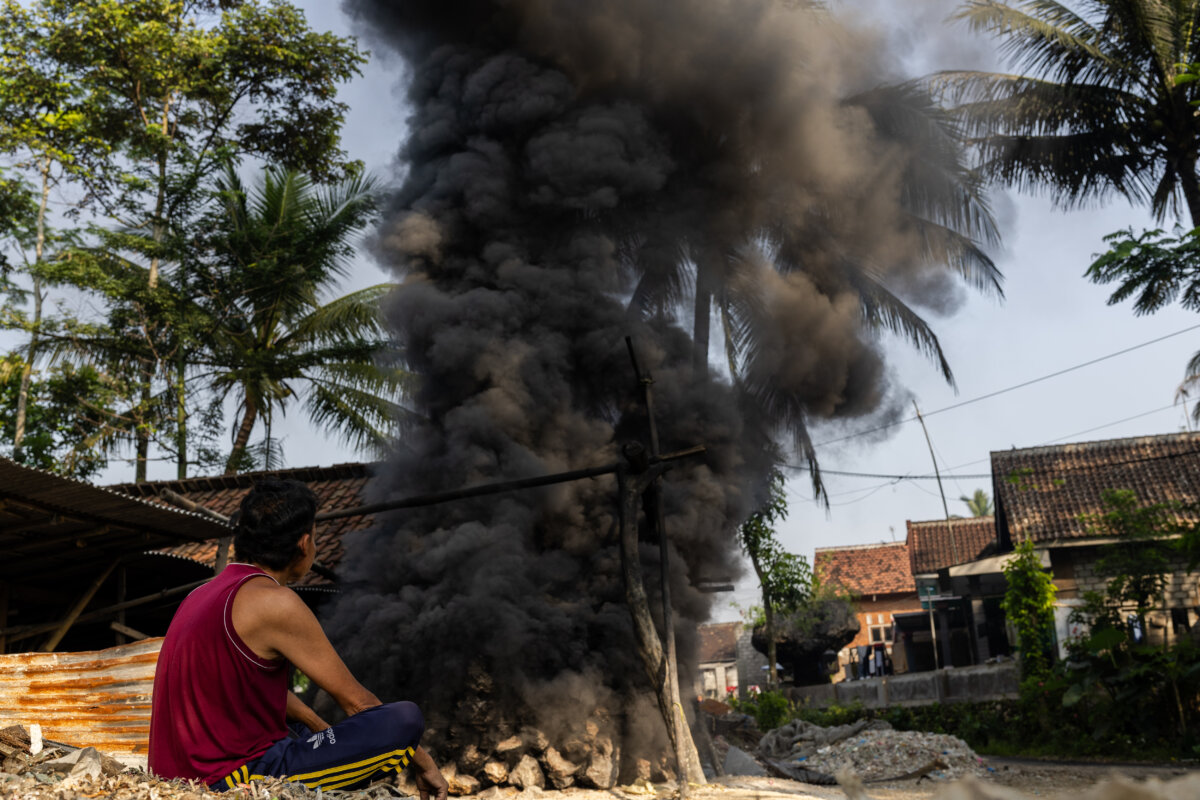
Jumaidi, 49, looks on as smoke rises from a limestone furnace fuelled by imported plastic waste to produce lime for cement and mortar and for agricultural use in Sumberejo village, Malang Regency, East Java, Indonesia, May 31, 2025. Plastic and paper waste is the main fuel used by villagers to process limestone.
Another major concern is dioxin. In 2019, ECOTON, along with the Nexus3 Foundation, IPEN, and the Arnika Association, released a joint report showing that dioxin levels in chicken eggs sampled near Bangun and Tropodo were the second highest in Asia, surpassed only by eggs from Bien Hoa, Vietnam, a site heavily contaminated by Agent Orange during the Vietnam War. These dioxin levels can have devastating consequences: cardiovascular disease, diabetes and cancer.
East Java is crossed by two of Java’s longest rivers: the Bengawan Solo and the Brantas. The Brantas stretches 320 kilometres from Malang to Surabaya, sustaining the lives of over 18.9 million people, nearly half of East Java's total population.
In Mojokerto, the Brantas splits into the Surabaya and Porong Rivers, both of which eventually drain into the Madura Strait. Smaller rivers, such as the Sadar, also originate from Brantas. Brantas River is a vital source of raw water for communities in Sidoarjo, Mojokerto, Gresik and Surabaya.
But that river is now under serious threat. Along its banks sit at least 11 paper mills, many of which discharge waste directly into the Brantas and its tributaries. These factories depend heavily on water as a key component in paper production. Yet, while they take from the river, they also give back - in the form of pollution.
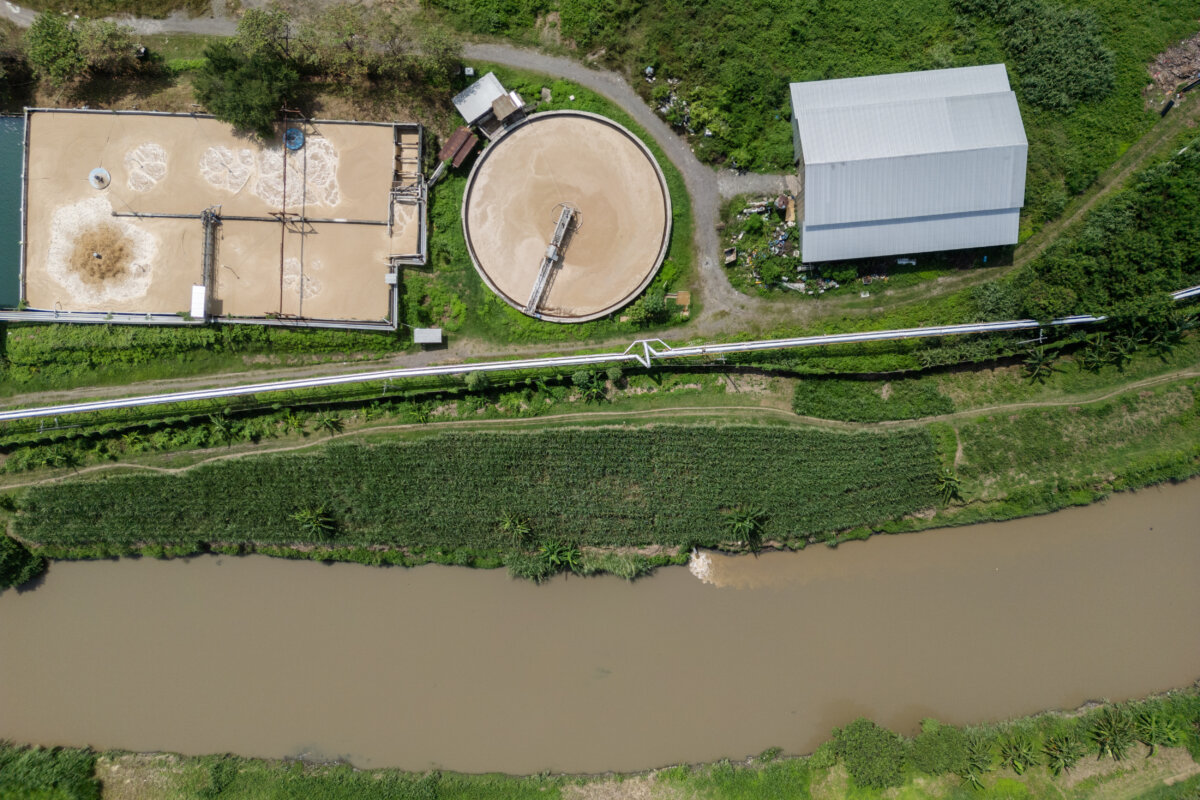
Brown liquid waste polluting a Sadar river from PT. Mekabox Internasional paper factory in Tanjang Rono village, Mojokerto Regency, East Java, Indonesia, 29 May, 2025. Untreated wastewater is being discharged into the Sadar River by a paper mill that recycles imported waste paper mixed with plastic scraps. This contaminated wastewater is poisoning the drinking water supplies for over 5 million people in the Brantas River Basin.
The newly imported waste brought in these paper factories will go through several processes - including the first cleaning before the waste is bought by residents to be sorted - this process is producing liquid waste that is discharged directly into the river, even altering its color due to contamination of chemical substances and microplastics coming from the liquid waste.
A 2023 field study by ECOTON found alarming evidence of contamination. Researchers collected a 250-millilitre water sample from the Porong River, a tributary of the Brantas, and discovered approximately 1,449 microplastic particles, which is 15 times higher than the normal concentrations found in other rivers.
"These particles vary in size, with some as small as plankton," said ECOTON researcher Rafika Aprilianti. "That’s what makes them so dangerous, they can be easily ingested by river fish."
The implications are alarming. When fish consume microplastics, those particles -often laced with chemicals and toxins - can enter the human body when the fish are eaten. "These substances can disrupt hormonal functions, damage tissue, and impair digestion," Rafika explained.
The government has issued several strict regulations governing waste imports. Chief among them is a Joint Decree signed by the Ministers of Environment, Trade, and Industry, which limits plastic contamination in imported paper waste to just 2 per cent.
This policy took effect in 2006 concerning the import of non-hazardous waste. According to the regulation, eligible waste must not be contaminated with toxic or hazardous materials (B3). Importers must secure an official import permit, along with a surveyor’s report, as proof of compliance.
However, the implementation is far from ideal. The problem arises when the garbage arriving in Indonesia is not entirely composed of paper waste, but also contains plastic and other hazardous waste in an amount exceeding the 2 per cent limit set by the government. ECOTON holds paper companies accountable for the sharp increase in plastic presence and have reported plastic contamination rates in imported paper waste reaching up to 35 per cent, far exceeding the regulatory limit.
These findings were swiftly refuted by Liana Bratasida, Chairwoman of the Indonesian Pulp and Paper Association. She argued that Indonesia's waste import practices still fall within acceptable limits as defined by the Institute of Scrap Recycling Industries (ISRI), a U.S.-based private trade association. According to Bratasida, the country faces an annual shortfall of 3.2 to 3.5 million tons of raw material for paper recycling.
On 1 January, 2025, the Indonesian Ministry of Environment and Forestry announced a significant step: halting the import of plastic scrap entirely. Moving forward, importers would only be allowed to bring in plastic waste with direct recommendations from this ministry.
Grassroots pressure is mounting. Last year, Nina sent a formal letter to the Consulate General of Australia and Japan in Surabaya. She urged both governments to take responsibility by stopping waste exports to Indonesia and managing their plastic domestically. "It’s not impossible, if I send similar letters to other waste-exporting countries," she warned.
Meanwhile, the World Health Organisation (WHO) has shifted its focus toward preventive measures. The organisation has urged nations to reduce plastic usage, invest in circular economies and expand recycling initiatives. Based on their studies, WHO classifies microplastics and nanoplastics as urgent health threats, citing risks to hormonal systems, digestion and long-term well-being.
This fundamental issue about how to resist the pressure of foreign imports remains unresolved.
Images by Garry Andrew Lotulung.
Text by Primagung Dary Riliananda.
By copying the embed code below, you agree to adhere to our republishing guidelines.